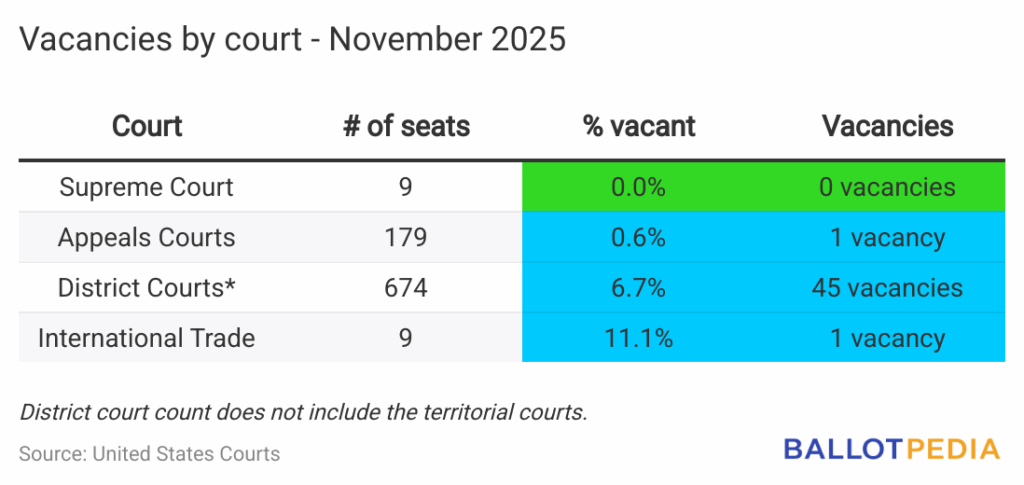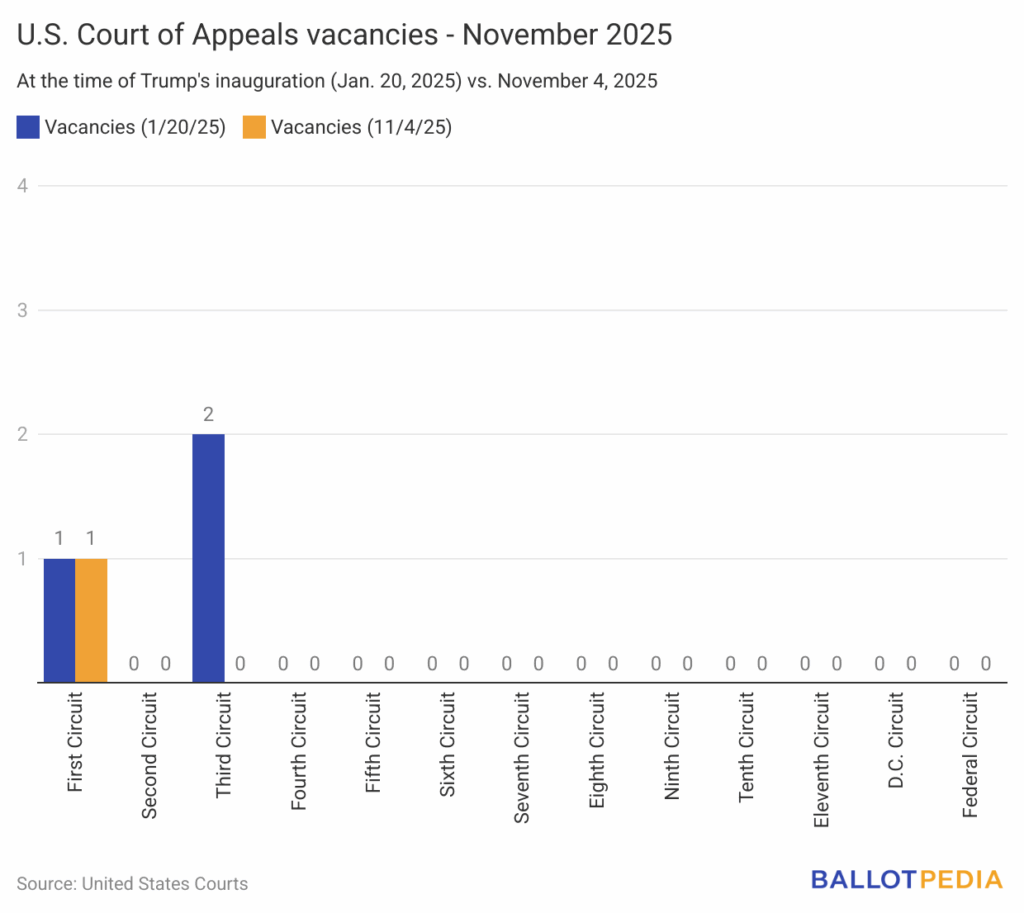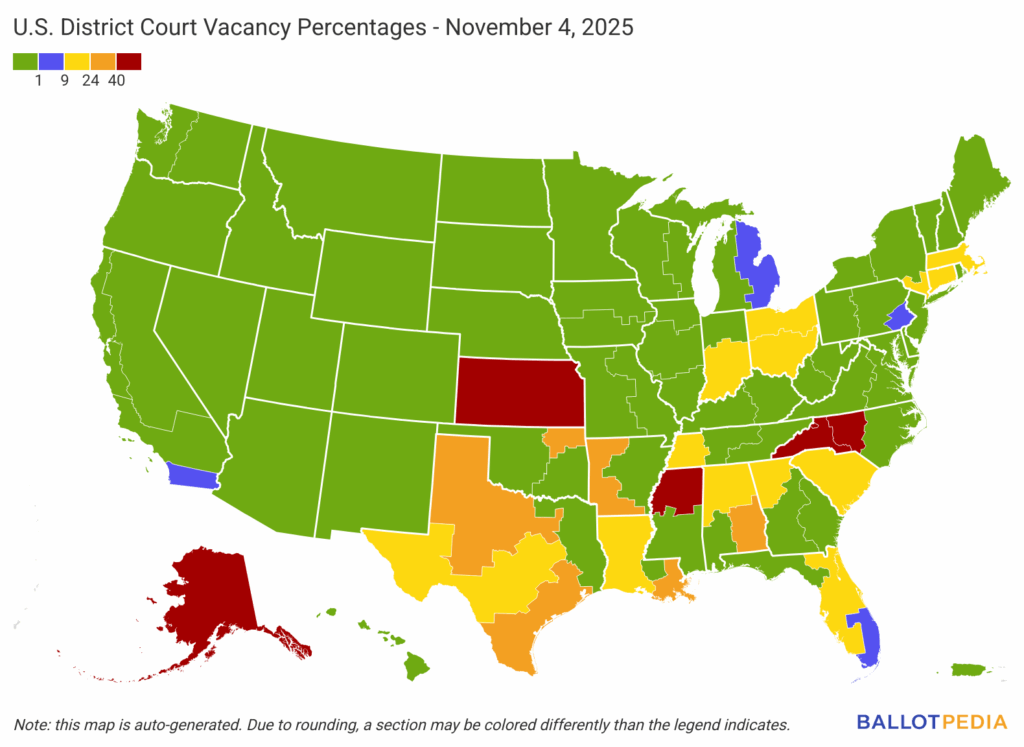Welcome to the November edition of Robe & Gavel, Ballotpedia’s newsletter about the Supreme Court of the United States (SCOTUS) and other judicial happenings around the U.S.
Don’t talk to me of solemn days
In autumn’s time of splendor,
Because the sun shows fewer rays,
And these grow slant and slender.
Why, it’s the climax of the year,—
The highest time of living!—
Till naturally its bursting cheer
Just melts into thanksgiving.
-Paul Laurence Dunbar
“Merry Autumn”
Welcome back, dear reader. We’re closing out the penultimate argument sitting of the year with plenty of court updates for you. Let’s gavel in!
Follow Ballotpedia on X and Bluesky or subscribe to the Daily Brew for the latest news and analysis.
We #SCOTUS and you can, too!
Grants
SCOTUS has accepted one new case to its merits docket since our Nov. 3 issue. To date, the court has agreed to hear 45 cases for the 2025-2026 term. SCOTUS dismissed one case after it was accepted. Twenty-seven cases have been scheduled for arguments.
Click the links below to learn more about these cases:
- Watson v. Republican National Committee (Election Law) originated from the U.S. Court of Appeals for the Fifth Circuit and concerns federal election-day laws, 2 U.S.C. § 7, 2 U.S.C. § 1, and 3 U.S.C. § 1.
Arguments
The Supreme Court will hear four arguments this week. Click here to read more about SCOTUS' current term.
Click the links below to learn more about these cases:
Nov. 10
- Landor v. Louisiana Department of Corrections and Public Safety concerns the Religious Land Use and Institutionalized Persons Act of 2000 (RLUIPA).
- The questions presented: “The question presented is whether an individual may sue a government official in his individual capacity for damages for violations of RLUIPA.”
- The GEO Group, Inc. v. Menocal concerns the collateral-order doctrine.
- The questions presented: "The question presented, which has divided the circuit courts 5-3, is whether an order denying a government contractor's claim of derivative sovereign immunity is immediately appealable under the collateral-order doctrine."
Nov. 12
- Fernandez v. United States concerns discretionary sentence reductions under 18 U.S.C. § 3582(c)(1)(A).
- The questions presented: “Whether the Second Circuit erred in recognizing extra-textual limitations on what information a court may consider when determining whether there exist extraordinary and compelling reasons warranting a sentence reduction under 18 U.S.C. § 3582(c)(1) (A).”
- Rutherford v. United States concerns the First Step Act and 18 U.S.C. § 3582(c)(1)(A)(i).
- The questions presented: “Whether, as four circuits permit but six others prohibit, a district court may consider disparities created by the First Step Act's prospective changes in sentencing law when deciding if ‘extraordinary and compelling reasons’ warrant a sentence reduction under 18 U.S.C. § 3582(c)(1)(A)(i)”
In its October 2025 term, SCOTUS heard arguments in 65 cases. Click here to read more about SCOTUS's previous term.
Opinions
SCOTUS has not ruled on any cases since our Nov. 3 edition. The court has not issued rulings in any cases so far this term.
The Federal Vacancy Count
The Federal Vacancy Count tracks vacancies, nominations, and confirmations to all U.S. Article III federal courts in a one-month period. This month's edition covers vacancy activity from Oct. 2 through Nov. 4 and compares Article III judicial appointments over time by president and by court type through Nov. 1 of their first year in office.
Highlights
- Vacancies: There have been three new judicial vacancies since the October 2025 report. There are 47 vacancies out of 870 active Article III judicial positions on courts covered in this report. Including the U.S. Court of Federal Claims and the U.S. territorial courts, 48 of 890 active federal judicial positions are vacant.
- Nominations: There were two new nominations since the October 2025 report.
- Confirmations: There were nine new confirmations since the October 2025 report.
Vacancy count for November 1, 2025
A breakdown of the vacancies at each level can be found in the table below. For a more detailed look at the vacancies in the federal courts, click here.

*Though the U.S. territorial courts are named as district courts, they are not Article III courts. They are created in accordance with the power granted under Article IV of the U.S. Constitution. Click here for more information.
New vacancies
Three judges left active status since the previous vacancy count, creating Article III life-term judicial vacancies. The president nominates individuals to fill Article III judicial position vacancies. Nominations are subject to U.S. Senate confirmation.
- Judge Cathy Seibel assumed senior status on the U.S. District Court for the Southern District of New York.
- Judge Nancy Torresen assumed senior status on the U.S. District Court for the District of Maine.
- Judge Michael Watson assumed senior status on the U.S. District Court for the Southern District of Ohio.
The following chart tracks the number of vacancies in the U.S. Courts of Appeals from President Donald Trump's (R) inauguration to the date indicated on the chart.

U.S. District Court vacancies
The following map shows the number of vacancies in the U.S. District Courts as of Nov. 4.

New nominations
President Donald Trump (R) announced two new nominations since the October 2025 edition.
- William J. Crain, to the U.S. District Court for the Eastern District of Louisiana
- Alexander Van Hook, to the U.S. District Court for the Western District of Louisiana
The president has announced 29 Article III judicial nominations since taking office on Jan. 20. For more information on the president’s judicial nominees, click here.
New confirmations
As of Nov. 7, the Senate has confirmed 17 of President Trump’s judicial nominees—thirteen district court judges, four appeals court judges—since January 2025.
- Edmund LaCour, to the U.S. District Court for the Northern District of Alabama.
- Jordan Pratt, to the U.S. District Court for the Middle District of Florida.
- Bill Lewis, to the U.S. District Court for the Middle District of Alabama.
- Rebecca Taibleson, to the U.S. Court of Appeals for the Seventh Circuit.
- Chad Meredith, to the U.S. District Court for the Eastern District of Kentucky.
- Bill Mercer, to the U.S. District Court for the District of Montana.
- Anne-Leigh Gaylord Moe, to the U.S. District Court for the Middle District of Florida.
- Harold Mooty, to the U.S. District Court for the Northern District of Alabama.
- Jennifer Mascott, to the U.S. Court of Appeals for the Third Circuit.
Comparison of Article III judicial appointments over time by president (1981-Present)
- Presidents have made an average of 22.8 judicial appointments through Nov. 1 of their first year in office. President Barack Obama (D) had the most appointees confirmed with 36, and President George W. Bush (R) had the fewest confirmations with 15.
- President Bill Clinton (D) made the most appointments through four years with 174. President George W. Bush (R) made the fewest through four years with 122.
- President Barack Obama (D) made the most appointments through two years with 134. President W. Bush made the fewest with 54.
- President Obama made the most appointments through one year in office with 45. President W. Bush made the fewest with 22.
Need a daily fix of judicial nomination, confirmation, and vacancy information? Click here for continuing updates on the status of all federal judicial nominees.
Or, keep an eye on this list for updates on federal judicial nominations.
Federal courts recent news
- Trump administration responds to Supreme Court order asking it for current position in SNAP payment dispute (updated) (SCOTUSblog)
Looking ahead
We’ll be back on Dec. 1 with a new edition of Robe & Gavel. Until then, gaveling out!
Contributions
Myj Saintyl compiled and edited this newsletter, with contributions from Sam Post and Ellie Mikus.

